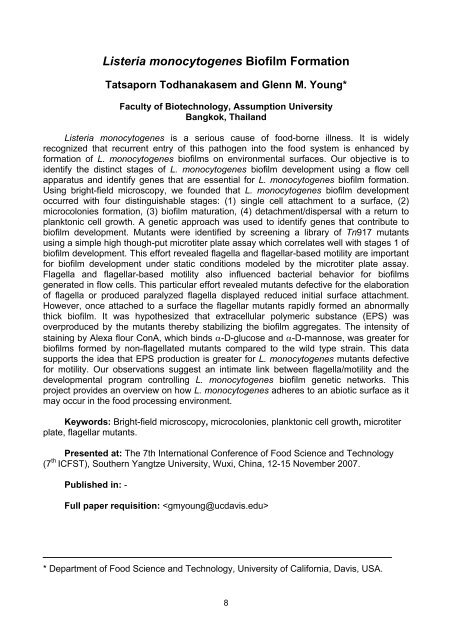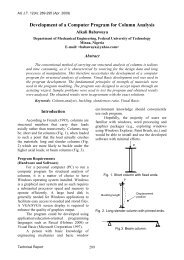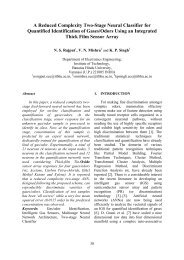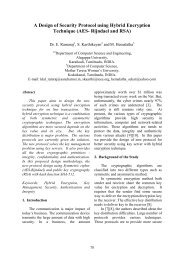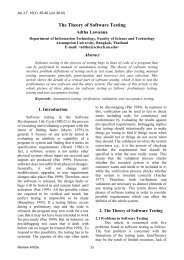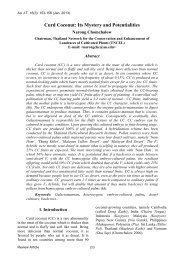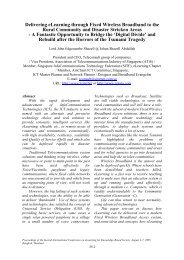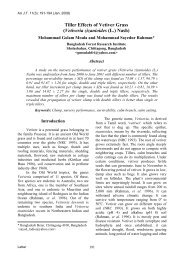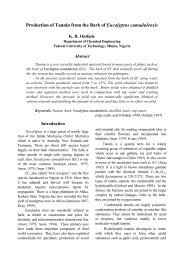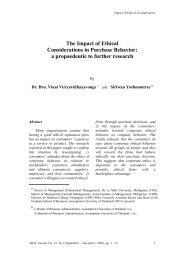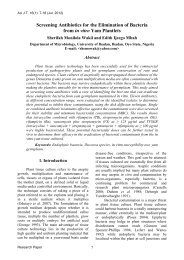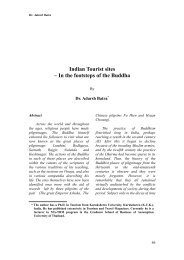AU Abstracts 2008 - AU Journal - Assumption University of Thailand
AU Abstracts 2008 - AU Journal - Assumption University of Thailand
AU Abstracts 2008 - AU Journal - Assumption University of Thailand
You also want an ePaper? Increase the reach of your titles
YUMPU automatically turns print PDFs into web optimized ePapers that Google loves.
Listeria monocytogenes Bi<strong>of</strong>ilm Formation<br />
Tatsaporn Todhanakasem and Glenn M. Young*<br />
Faculty <strong>of</strong> Biotechnology, <strong>Assumption</strong> <strong>University</strong><br />
Bangkok, <strong>Thailand</strong><br />
Listeria monocytogenes is a serious cause <strong>of</strong> food-borne illness. It is widely<br />
recognized that recurrent entry <strong>of</strong> this pathogen into the food system is enhanced by<br />
formation <strong>of</strong> L. monocytogenes bi<strong>of</strong>ilms on environmental surfaces. Our objective is to<br />
identify the distinct stages <strong>of</strong> L. monocytogenes bi<strong>of</strong>ilm development using a flow cell<br />
apparatus and identify genes that are essential for L. monocytogenes bi<strong>of</strong>ilm formation.<br />
Using bright-field microscopy, we founded that L. monocytogenes bi<strong>of</strong>ilm development<br />
occurred with four distinguishable stages: (1) single cell attachment to a surface, (2)<br />
microcolonies formation, (3) bi<strong>of</strong>ilm maturation, (4) detachment/dispersal with a return to<br />
planktonic cell growth. A genetic approach was used to identify genes that contribute to<br />
bi<strong>of</strong>ilm development. Mutants were identified by screening a library <strong>of</strong> Tn917 mutants<br />
using a simple high though-put microtiter plate assay which correlates well with stages 1 <strong>of</strong><br />
bi<strong>of</strong>ilm development. This effort revealed flagella and flagellar-based motility are important<br />
for bi<strong>of</strong>ilm development under static conditions modeled by the microtiter plate assay.<br />
Flagella and flagellar-based motility also influenced bacterial behavior for bi<strong>of</strong>ilms<br />
generated in flow cells. This particular effort revealed mutants defective for the elaboration<br />
<strong>of</strong> flagella or produced paralyzed flagella displayed reduced initial surface attachment.<br />
However, once attached to a surface the flagellar mutants rapidly formed an abnormally<br />
thick bi<strong>of</strong>ilm. It was hypothesized that extracellular polymeric substance (EPS) was<br />
overproduced by the mutants thereby stabilizing the bi<strong>of</strong>ilm aggregates. The intensity <strong>of</strong><br />
staining by Alexa flour ConA, which binds α-D-glucose and α-D-mannose, was greater for<br />
bi<strong>of</strong>ilms formed by non-flagellated mutants compared to the wild type strain. This data<br />
supports the idea that EPS production is greater for L. monocytogenes mutants defective<br />
for motility. Our observations suggest an intimate link between flagella/motility and the<br />
developmental program controlling L. monocytogenes bi<strong>of</strong>ilm genetic networks. This<br />
project provides an overview on how L. monocytogenes adheres to an abiotic surface as it<br />
may occur in the food processing environment.<br />
Keywords: Bright-field microscopy, microcolonies, planktonic cell growth, microtiter<br />
plate, flagellar mutants.<br />
Presented at: The 7th International Conference <strong>of</strong> Food Science and Technology<br />
(7 th ICFST), Southern Yangtze <strong>University</strong>, Wuxi, China, 12-15 November 2007.<br />
Published in: -<br />
Full paper requisition: <br />
* Department <strong>of</strong> Food Science and Technology, <strong>University</strong> <strong>of</strong> California, Davis, USA.<br />
8


